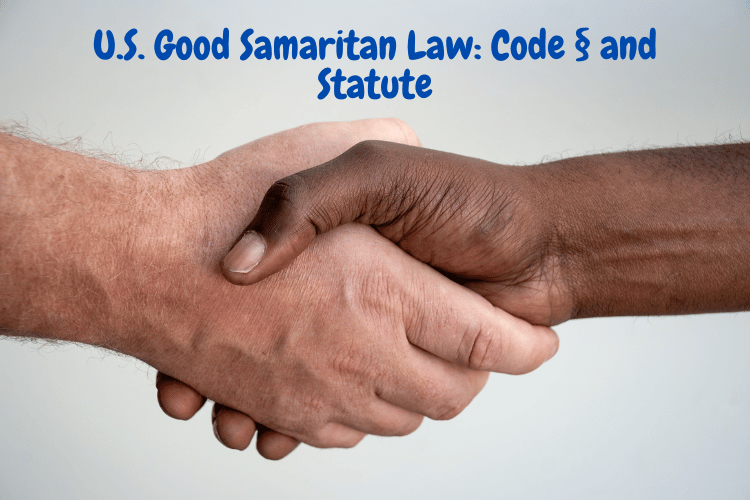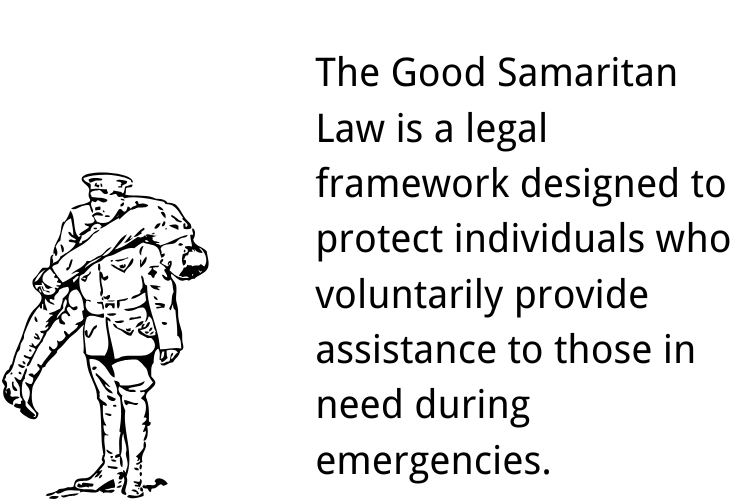
The Good Samaritan Law is a vital legal framework that encourages individuals to step in and provide assistance during emergencies without fear of legal repercussions. By offering protection to those who act in good faith, this law fosters a culture of community responsibility and ensures that help is readily available when it is needed most. Whether you're a trained professional or a concerned bystander, understanding the nuances of this law can empower you to act confidently in critical situations. This article delves into the key aspects of the Good Samaritan Law, its variations across states, and its impact on healthcare providers and everyday citizens.
Understanding the Good Samaritan Law
Definition and Purpose of the Good Samaritan Law
The Good Samaritan Law is a legal framework designed to protect individuals who voluntarily assistthose in need during emergencies. Its primary purpose is to encourage bystanders to step in and offer help without the fear of being held legally liable for unintended consequences. These laws aim to foster a sense of community responsibility and ensure that people are not deterred from acting in critical situations due to concerns about potential lawsuits. By offering legal immunity, the Good Samaritan Law creates a safer environment where individuals can act in good faith to save lives or prevent harm. For example, if someone witnesses a car accident and provides first aid to an injured person, the Good Samaritan Law typically shields them from being sued if their actions inadvertently cause further injury. However, this protection generally applies only when the assistance is given voluntarily, without expectation of compensation, and in good faith. It does not cover gross negligence or willful misconduct.
Historical Context of Good Samaritan Laws
The concept of the Good Samaritan Law has its roots in the biblical parable of the Good Samaritan, which emphasizes the moral obligation to help others in distress. However, the modern legal framework emerged in the mid-20th century as societies recognized the need to address the hesitation many people felt about intervening in emergencies. In the United States, the first Good Samaritan Law was enacted in California in 1959, primarily to protect medical professionals who provided emergency care outside of their regular practice. Over time, these laws expanded to include laypersons, reflecting a broader societal shift toward encouraging civic responsibility. Today, variations of the Good Samaritan Law exist in many countries, each tailored to the specific legal and cultural context of the region.Key Provisions of the Good Samaritan Law
While the specifics of the Good Samaritan Law vary by jurisdiction, several key provisions are commonly included:- Legal Immunity for Good Faith Actions: Individuals who provide emergency assistance in good faith are generally protected from civil liability. This immunity applies as long as the helper acts within the scope of their knowledge and training.
- Exclusion of Gross Negligence: The law does not protect individuals who act recklessly or with gross negligence. For instance, if a person administers aid in a way that is clearly harmful or outside their expertise, they may still face legal consequences.
- Voluntary Assistance: Protection under the law typically applies only to those who offer help voluntarily and without expectation of compensation. Paid professionals, such as paramedics, are usually governed by separate legal standards.
- Emergency Situations Only: The law is designed to apply in genuine emergencies where immediate action is required to prevent harm or save lives. It does not cover non-urgent situations or actions taken after the emergency has passed.
- Jurisdictional Variations: Different regions may have unique provisions or limitations. For example, some states in the U.S. extend protection to the use of automated external defibrillators (AEDs), while others may have specific requirements for reporting the incident to authorities.
The Good Samaritan Act in Different States
Variations in State Good Samaritan Laws
The Good Samaritan Act is not a one-size-fits-all legal framework; its provisions vary significantly across states, reflecting regional priorities and legal nuances. While the overarching goal of these laws is to encourage individuals to assist in emergencies without fear of legal repercussions, the specifics differ in terms of who is protected, the types of emergencies covered, and the conditions under which immunity applies. For instance, some states extend legal protection to anyone who provides aid in good faith, regardless of their level of training, while others limit immunity to trained professionals or individuals certified in first aid or CPR. Additionally, certain jurisdictions include specific provisions for the use of automated external defibrillators (AEDs), ensuring that bystanders who use these devices are shielded from liability. Other states may impose requirements such as reporting the incident to authorities or ensuring that the assistance provided does not exceed the helper's level of expertise. These variations highlight the importance of understanding the specific Good Samaritan laws in your state. While the intent of the legislation is consistent nationwide, the details can significantly impact how and when individuals choose to intervene in emergencies.Notable State-Level Examples
Several states have unique provisions in their Good Samaritan Acts that set them apart from others. These examples illustrate how local laws address specific concerns and encourage public participation in emergency response.- California: As the first state to enact a Good Samaritan Law, California's legislation initially focused on protecting medical professionals. Over time, it expanded to include laypersons, with specific provisions for the use of AEDs and protections for those assisting in drug overdose situations.
- New York: New York's Good Samaritan Act includes a "duty to act" clause for certain professionals, such as off-duty healthcare workers, requiring them to provide assistance in emergencies. The state also offers immunity to individuals who report drug overdoses, aiming to reduce fatalities by encouraging timely intervention.
- Texas: Texas provides broad protections under its Good Samaritan Law, covering both medical professionals and untrained bystanders. The state also includes specific provisions for disaster scenarios, ensuring that volunteers assisting during natural disasters are shielded from liability.
- Florida: Florida's law emphasizes the importance of good faith actions, offering immunity to those who provide emergency care without expecting compensation. The state also includes protections for individuals who assist in water-related emergencies, such as drowning incidents.
Impact of Good Samaritan Acts on Healthcare Providers
Good Samaritan laws have a profound impact on healthcare professionals, particularly when they are off duty or outside their usual work environment. These laws provide a safety net, ensuring that medical practitioners can offer their expertise in emergencies without fear of legal consequences. However, the level of protection varies depending on the state and the circumstances under which the assistance is provided. In many states, healthcare providers are held to a higher standard of care due to their training and expertise. While they are generally protected under Good Samaritan laws, they may still face liability if their actions are deemed grossly negligent or if they exceed the scope of their professional knowledge. For example, a doctor providing emergency care at the scene of an accident is typically protected, but they could be held accountable if they perform a procedure they are not qualified to conduct. Additionally, some states impose a "duty to act" on healthcare providers, requiring them to intervene in emergencies even when they are off duty. This obligation underscores the unique role of medical professionals in society and the expectation that they will use their skills to save lives whenever possible. By offering legal protections and clarifying the responsibilities of healthcare providers, Good Samaritan laws play a crucial role in ensuring that medical expertise is available during emergencies, ultimately benefiting both professionals and the public.Legal Implications of Good Samaritan Laws
Protection for Physicians and First Responders
Good Samaritan laws provide crucial legal protections for medical professionals and emergency responders who offer assistance during emergencies. These protections are designed to ensure that doctors, nurses, paramedics, and other trained individuals can act swiftly without hesitation, knowing they are shielded from potential lawsuits. For instance, a physician who performs CPR on a stranger at a public event is typically protected from liability, provided their actions are in good faith and within the scope of their expertise. However, the level of protection for healthcare professionals often depends on the jurisdiction. In some states, these laws explicitly cover off-duty medical personnel, while others may impose additional requirements, such as the need for the intervention to be voluntary and without compensation. First responders, such as firefighters and paramedics, are also generally protected when they act outside their official duties, ensuring they can use their training to save lives in unexpected situations. These legal protections not only encourage trained professionals to assist in emergencies but also foster public trust in their ability to act without fear of legal repercussions. By reducing the risk of liability, Good Samaritan laws empower medical experts and first responders to focus on providing life-saving care.Limitations and Exceptions in the Good Samaritan Law
While Good Samaritan laws offer broad protections, they are not without limitations. These exceptions are in place to prevent misuse of the law and ensure that individuals act responsibly when providing aid. One of the most significant limitations is the exclusion of gross negligence or willful misconduct. For example, if a person administers aid recklessly or in a manner that causes harm, they may still face legal consequences. Another common limitation is the requirement for the assistance to be provided in good faith. This means that the individual offering help must genuinely intend to assist and not act with ulterior motives. Additionally, many jurisdictions specify that the law applies only to emergencies, excluding situations where the need for help is not immediate or life-threatening. Some states also impose restrictions based on the helper's level of training. For instance, untrained bystanders may be protected only for basic actions, such as calling for help or providing comfort, while more advanced interventions may require certification or expertise. Furthermore, Good Samaritan laws typically do not cover individuals who expect compensation for their assistance, as this falls outside the scope of voluntary aid. These limitations ensure that the law is applied fairly and responsibly, balancing the need to encourage assistance with the importance of accountability.Scenarios Without a Good Samaritan Law
In regions or situations where Good Samaritan laws do not apply, the legal landscape can be significantly different, often discouraging individuals from stepping in to help. Without these protections, bystanders may hesitate to provide aid due to the fear of being sued if their actions inadvertently cause harm. This reluctance can lead to tragic outcomes, as people may avoid intervening even in life-threatening emergencies. For example, in the absence of legal immunity, a passerby who attempts to assist a choking victim might face legal action if their intervention results in injury. Similarly, a driver who stops to help at the scene of an accident could be held liable if their actions are perceived as contributing to further harm. These scenarios highlight the importance of Good Samaritan laws in creating a supportive environment where individuals feel empowered to act without fear of legal repercussions. In some cases, the lack of a Good Samaritan law may also place a greater burden on emergency services, as bystanders may choose to wait for professional help rather than risk legal consequences. This delay can be critical in situations where immediate action is necessary to save lives or prevent further harm. By understanding the potential risks and challenges in areas without these legal protections, individuals can better appreciate the value of Good Samaritan laws in fostering a culture of mutual aid and responsibility.Challenges and Criticisms of Good Samaritan Laws
Common Misconceptions about Good Samaritan Laws
One of the most significant challenges surrounding Good Samaritan laws is the widespread misunderstanding of their scope and application. Many people mistakenly believe that these laws provide blanket immunity for any actions taken during an emergency, which is not the case. For instance, while the laws protect individuals acting in good faith, they do not shield those who act recklessly or beyond their level of expertise. This misconception can lead to hesitation or overconfidence, both of which can have serious consequences in critical situations. Another common misunderstanding is the belief that Good Samaritan laws apply universally across all states or countries. In reality, the provisions vary widely depending on the jurisdiction, and what is protected in one region may not be covered in another. For example, some states offer immunity for the use of automated external defibrillators (AEDs), while others may not explicitly address this scenario. This lack of uniformity can create confusion and discourage people from stepping in to help. Additionally, there is often a fear among bystanders that they could still face legal repercussions despite the existence of these laws. This fear is fueled by high-profile cases where Good Samaritans were sued, even if the lawsuits were ultimately dismissed. Addressing these misconceptions through public education and awareness campaigns is essential to ensure that more people feel confident about offering assistance in emergencies.Legal Challenges Faced by Good Samaritans
Despite the protections offered by Good Samaritan laws, individuals who provide aid in emergencies may still encounter legal hurdles. One of the most significant challenges is the ambiguity in determining what constitutes "good faith" or "reasonable care." For example, a bystander who performs CPR on an unconscious person might face scrutiny if the victim later claims that the procedure caused additional harm. In such cases, the burden of proving that the actions were reasonable and in good faith can be daunting. Another legal challenge arises from the varying interpretations of gross negligence. While most Good Samaritan laws exclude protection for reckless or negligent behavior, the definition of these terms can differ from one jurisdiction to another. This inconsistency can lead to uncertainty about whether a particular action is covered under the law, potentially deterring individuals from intervening. Furthermore, Good Samaritans may face challenges related to documentation and reporting. In some states, individuals are required to report the incident to authorities or provide a detailed account of their actions. Failure to comply with these requirements could result in legal complications, even if the assistance provided was otherwise lawful and well-intentioned. These legal challenges highlight the need for clearer guidelines and consistent application of Good Samaritan laws to ensure that individuals who act in emergencies are adequately protected.Recommendations for Improvement
To address the challenges and criticisms of Good Samaritan laws, several improvements can be made to enhance their effectiveness and encourage greater public participation in emergency response efforts:- Standardization Across Jurisdictions: Establishing uniform provisions for Good Samaritan laws nationwide would reduce confusion and ensure that individuals are protected regardless of where they provide assistance. This could include consistent definitions of key terms such as "gross negligence" and "good faith."
- Public Education Campaigns: Increasing awareness about the scope and limitations of Good Samaritan laws is crucial to dispel misconceptions and build confidence among potential helpers. Educational initiatives could include workshops, informational materials, and public service announcements.
- Expanded Protections: Extending legal immunity to cover a broader range of scenarios, such as the use of AEDs or assistance during natural disasters, would encourage more people to step in without fear of liability. Additionally, providing protections for individuals with limited training who act within their capabilities could further promote civic responsibility.
- Simplified Reporting Requirements: Streamlining the process for documenting and reporting emergency assistance would reduce the burden on Good Samaritans and minimize the risk of legal complications. This could include the use of standardized forms or online reporting systems.
- Incentives for Training: Offering incentives for first aid and CPR training, such as tax credits or reduced insurance premiums, would equip more people with the skills needed to provide effective assistance. Trained individuals are more likely to act confidently and responsibly in emergencies, reducing the likelihood of legal disputes.
Frequently Asked Questions
Q: What is the Good Samaritan Law?
A: The Good Samaritan Law is a legal framework designed to protect individuals who voluntarily assist those who are injured or in danger. It encourages bystanders to provide help during emergencies without fear of legal consequences, as long as their actions are carried out in good faith and without gross negligence.
Q: How does the Good Samaritan Law protect individuals?
A: This law grants immunity from civil liability for damages that may result from acts or omissions while providing emergency care. Essentially, if someone helps another person in good faith during an emergency, they are protected from being sued for civil damages, provided their actions are not grossly negligent or intentionally harmful.
Q: What constitutes gross negligence under the Good Samaritan Law?
A: Gross negligence refers to actions that show a significant lack of care or a serious departure from the expected standard of care. If someone’s actions are deemed grossly negligent, they may lose the legal protections offered by the Good Samaritan Law and could be held liable for damages.
Q: Are there any limitations to the Good Samaritan Law?
A: Yes, the law does not protect individuals who act with gross negligence, willful misconduct, or intentional harm. Additionally, the specifics of the law vary by jurisdiction, meaning the level of protection and conditions may differ depending on local statutes and regulations.
Q: Can a bystander be prosecuted for failing to assist during an emergency?
A: Generally, the Good Samaritan Law does not impose a legal obligation to act. However, some jurisdictions have "duty to assist" laws that require individuals to help someone in danger if it can be done safely. Failure to comply with such laws could result in legal consequences in those areas.
Q: What should a person do if they witness an overdose situation?
A: If someone witnesses an overdose, they should immediately call for medical assistance. Many jurisdictions include overdose-specific provisions in their Good Samaritan laws, protecting individuals who seek help in good faith from legal liability. This ensures the focus remains on saving lives without fear of repercussions.
Q: What types of assistance are covered under the Good Samaritan Law?
A: The law typically covers a variety of actions, such as administering basic first aid, calling emergency services, or offering comfort to someone in distress. As long as the assistance is provided voluntarily, in good faith, and without expectation of payment, individuals are generally protected from legal liability.
Q: What is the expectation of compensation when assisting under the Good Samaritan Law?
A: Assistance provided under the Good Samaritan Law must be voluntary and without any expectation of compensation. The law is designed to encourage altruistic acts of kindness and community support, ensuring that individuals can help others without fear of legal or financial repercussions.
Q: Is professional medical personnel exempt from liability under the Good Samaritan Law?
A: In many cases, medical professionals are also protected when they provide emergency care outside their regular duties. However, they must act in good faith and avoid gross negligence to retain these protections. The specifics may vary by jurisdiction, so professionals should be aware of local laws.
Conclusion
The Good Samaritan Law plays a crucial role in promoting altruism and ensuring timely intervention in emergency situations. By providing legal immunity to those who act in good faith, it removes barriers that might otherwise deter individuals from offering help. However, understanding the limitations and variations of this law is equally essential to ensure responsible and practical assistance. Whether you're a bystander or a professional, knowing your rights and responsibilities under the Good Samaritan Law can make a significant difference in saving lives and fostering a safer community.








 Login with Google
Login with Google Login with Facebook
Login with Facebook